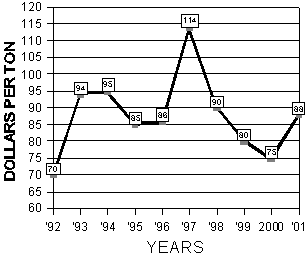Alfalfa Report
Yuma County, Arizona
June 18, 2001
Yuma County Office
2200 W. 28th Street, Ste. 102
Yuma, AZ 85364
(520) 726-3904
(520) 726-8472 FAX
Production Update:
PDF version, 17KB
Barn Fires: Baled hay can catch fire if stored between 30 to 40% moisture due to heat produced by microorganisms and plant respiration. Hay baled at safe moisture levels of 20% or less may rise to a temperature of 130 to 140° F for a few days before gradually cooling off. If hay temperature rises above 140° F, temperature should be monitored every few hours. At temperatures between 150 and 160° F, it is time to prepare to remove hot hay from the stack or secure a source of water in case temperature continues to rise. It would be wise to call the fire department when hay temperature exceeds 180° F. When temperature reaches 200° F, bales may burst into flames when removed from the stack if not wetted.
Insect Management: Spider mites do not often cause wide spread damage to alfalfa grown for hay and damage may be associated with water stress. Spider mites feed by inserting long needle-like mouth parts into leaves removing plant sap causing a yellow stippling on leaves and leaves are covered with webbing. Severe feeding causes necrosis, leaves turn brown, become dry and drop from the plant. Infestations are usually confined to the lower leaves so damage starts in the lower plant canopy moving upward. Feeding damage reduces yield, quality and retards regrowth. Spider Mite Species in Western Arizona & Southern California include: carmine spider mite (T. cnnabarinus Boisdival); desert spider mite (T. desortorum Banks); strawberry mite (T. turkestani Ugarov & Nikolski); and twospotted spider mite (Tetranychus urticae Koch). Avoid using pyrethroid insecticides for alfalfa pest control; they can flare spider mite infestations. Minimizing crop stress through improved irrigation; when fields are watered, infestations often clears up in a few days. When severe infestations occur, sulfur may be used to suppress the populations.
Weed Control: Swine cress (Coronopus didymus) was found
this year in an alfalfa field on the south Yuma Mesa. This is a winter
annual in the mustard family that is a common urban weed but can be a
problem in alfalfa as well. The more difficult to control and invasive,
coronopus squamatus, is more vigorous and invasive and is found in the
Imperial Valley but has not, to our knowledge, been found in Yuma. Both
are controlled with Pursuit while many other herbicides are weak or ineffective
on these weeds.
| Market Summary |
High
|
Low
|
Average
|
Off grade
|
| Past 2 Weeks ( 2001) |
95
|
85
|
88
|
80-90
|
| Last Year ( 2000) |
80
|
70
|
75
|
60-70
|
10 Year Summary (June 4, to June 17, 1992-2001):

Issued in furtherance of Cooperative Extension work, acts of May 8 and June 30, 1914, in cooperation with the U.S. Department of Agriculture, James A. Christenson, Director Cooperative Extension, College of Agriculture and Life Sciences, The University of Arizona.
The University of Arizona is an equal opportunity, affirmative action institution. The University does not discriminate on the basis of race, color, religion, sex, national origin, age, disability, veteran status, or sexual orientation in its programs and activities.
Any products, services, or organizations that are
mentioned, shown, or indirectly implied in this web document do not imply
endorsement by The University of Arizona.
Information provided by:
Barry Tickes, btickes@ag.arizona.edu Extension Agent, Yuma County
Michael Ottman, mottman@ag.arizona.edu Agronomy Specialist
College of Agriculture, The University of Arizona.
Eric Natwick, etnatwick@ucdavis.edu UCCE Imperial County - Farm Advisor
University of California, Davis, CA.
Material written June 8, 2001.
Forages: Crop Mgmt | Soil Mgmt | Irrigation | Alfalfa Reports | Insects | Diseases | Weeds | Pesticides
Home | Other Crops | Forages
For more Arizona Production Ag Information:
Home | Cotton | Veggies| Forages | Grains | Citrus | Crop x Crop | Insects | Diseases| Weeds | Pesticides | News | Weather | Research | Photos | Contacts | General Info. | Site Map
Copyright © 2001 University of Arizona,
College of Agriculture and Life Sciences
Webmaster: Al Fournier (fournier@ag.arizona.edu)